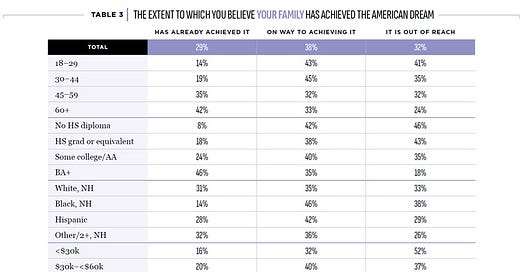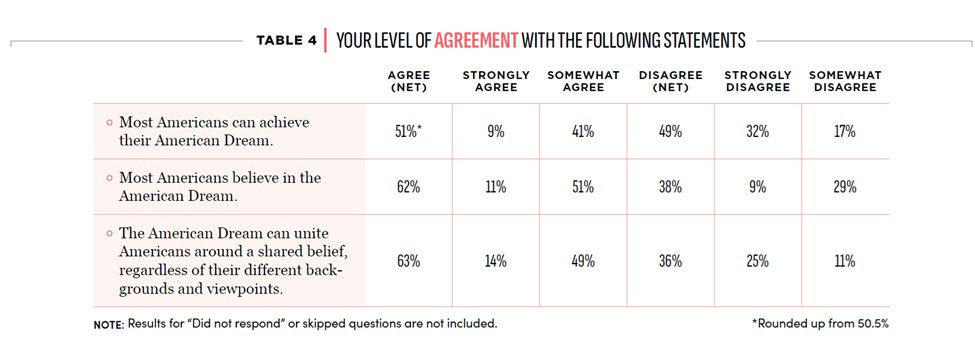The promise of the pursuit of happiness has been around since before our nation was founded. You can even say that the settlers were dreamers chasing the American Dream, moving across the Atlantic Ocean looking for better, richer, and fuller lives. Their descendants, led by the Founding Fathers, started their own American Dream of building a new nation through the American Revolution and put that pursuit of happiness and freedom into action.
In a speech a few years ago, Lord Rabbi Sacks defined the Declaration of Independence as the covenant of the United States. He stated that “a covenant is about neither wealth nor power, but about the bonds of belonging and of collective responsibility. And to put it as simply as I can, the social contract creates a state, but the social covenant creates a society . . . the social covenant in the Declaration of Independence in 1776 and its social contract in the Constitution in 1787.”
This social covenant put forth the promise of the American Dream. After the country’s early stain of slavery, even an abolitionist like Frederick Douglass, who certainly had harsh words for the country’s leadership, was still encouraged by “the Declaration of Independence, the great principles it contains, and the genius of American Institutions.” And even after slavery was abolished, while enduring blatant discrimination and Jim Crow laws, Martin Luther King Jr. remarked that his work was about cashing in the promissory note that included the inalienable rights to life, liberty, and the pursuit of happiness put forth in the Declaration of Independence and Constitution.
In the popular narrative of yesteryear, the stories of Horatio Alger sparked the imaginations of Americans as did the underdog stories of people who chased their American Dreams, beating the odds, and climbing both the income ladder and the status ladder by becoming respected members of society, regardless of where they started.
In 1931, James Truslow Adams put forth the best definition of the American Dream, still used to this day:
[The American Dream] is that dream of a land in which life should be better and richer and fuller for every man and woman, with opportunity for each according to his ability or achievement. . . . It is not a dream of motor cars and high wages merely, but a dream of a social order in which each man and each woman shall be able to attain to the fullest stature of which they are innately capable, and be recognized by others for what they are, regardless of the fortuitous circumstances of birth or position.
Despite all that progress and how resilient the American Dream has been throughout the last four centuries, the current narrative is that the American Dream is on life support. That is according to many elites, media personalities, politicians, and even some polls showing that Americans are souring on the American Dream.
Polls that defined the American Dream as “if you work hard, you’ll get ahead,” showed that only 27% of people agreed with that statement, down from 50% in 2010, here and here. Other media coverage even encourages people to look for the American Dream outside of America. This souring attitude is also represented in pop culture where even Captain America thinks that the American Dream is dead.
Our latest annual survey tracking attitudes about the American Dream at the Archbridge Institute shows that indeed there are more people who are pessimistic than in the past, with 32% now saying the American Dream is out of reach.
Archbridge Institute American Dream Snapshot, 2024
This is up from 24% last year as Table 2 shows:
Source: Archbridge Institute American Dream 2024 Snapshot, 2024
The negative results are mainly driven by younger cohorts, especially the 19–28-year-old cohort. In recent years, people in that cohort have experienced higher costs of living with rising inflation and slowed economic growth. Costlier borrowing rates for mortgages and loans have been higher than in the past, all of which drives Gen Z to have the highest borrowing rates for mortgages.
Source: Archbridge Institute American Dream 2024 Snapshot, 2024
Also, as the U.S. Bureau of Labor Statistics reports, youth employment continues to be low at only 70.8%, down from a high of 79% in the 1980s. This could affect the pessimism of younger generations about the American Dream. As fewer young people are working, they’re obviously generating less income for themselves, but they’re also losing opportunities to find meaning in work or develop important soft skills for later in life. A recent analysis on attitudes from young people about various topics shows that they are more pessimistic about the future overall. That, coupled with anxiety and stress, can certainly make them more defense-oriented instead of growth-oriented.
Americans also sour when asked about other people’s chances, with 49% of respondents saying that they don’t think others will be able to achieve their American Dreams.
Source: Archbridge Institute American Dream 2024 Snapshot, 2024
However, I believe we should still see the glass half full. As we can see in the first table, even though people are more pessimistic, almost 7 in 10 Americans are still hopeful and believe they have either achieved the American Dream or are on their way to achieving it. And as we can see in Table 4, 51%—a slight majority—still agree that most Americans can achieve their American Dream.
As a side note, this result is very similar to our previous survey on hope. When we asked if people were hopeful about their own future, they overwhelmingly said yes, to the tune of 82%. But as we people were less optimistic about the future of the country overall, to the tune of 54%. This is similar to asking people about their own chances of achieving the American Dream, 67%, in comparison to asking if they believe others will achieve it, 51%.
Another thing to be hopeful about is that, as Table 4 shows, most Americans still believe in the idea of the American Dream, 62%, and they believe that the American Dream can unite Americans, 63%.
Why does it matter if we have a more positive or negative view of the American Dream?
It matters because the American Dream offers a unifying narrative for a country desperately in need of it during a time of pessimism, doomerism, and polarization. It matters because the American Dream keeps people hopeful about the future; it keeps people thinking about an aspirational vision for their own lives and that of their neighbors.
So, across many of the questions in our survey, the majority of people still believe the American Dream is alive and well. And as we’ll show in future posts, this fact remains true across the rest of the questions on various topics related to the American Dream. There are many challenges ahead, certainly, and there are still barriers to overcome, but this is a more hopeful view that we as a nation desperately need. The American Dream is the unifying vision statement for the United States as James Truslow Adams defined it decades ago.







